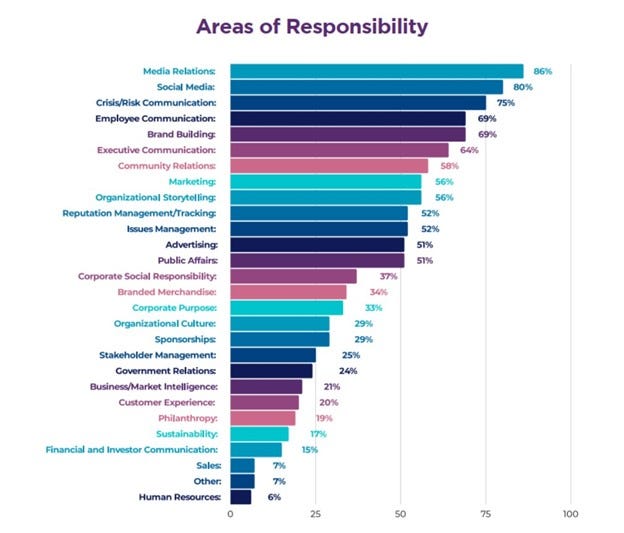views

We’re all familiar with the famous quote, “change is the only constant in life,” and communicators perhaps know this better than anyone.
To that end, the Institute for Public Relations (IPR) and PRNEWS conducted a survey of PR professionals “to find out how companies organize and evolve their communication function, including headcounts, reporting lines, strategic choices around structure and function, and areas of improvement. This study also assessed the efficacy and challenges of the structure of the communication function.”[1]
For background: The online survey was conducted between November 2019 and March 2021, to which 318 public relations professionals responded. Also, in this report, communication “function” is used in place of communications department.

In summary
Especially given the past 18 months (of the pandemic), it should come as no surprise that one of the top three functional responsibilities identified was crisis or risk communications.
It may also be unsurprising that the most frequently mentioned challenge ahead (over the next two years) is lack of resources — staffing headcounts and budget. Reorganizations, silos, and the necessity for more qualified people were also among the frequently mentioned impending challenges. In addition, some cited the desire for better clarification of roles.
Good news, bad news
As PRNEWS stated in their write-up about the report, “Begging Charles Dickens’s pardon, for PR it’s the best of times and the worst.”
With the convergence and evolution of PR and marketing, communicators’ responsibilities have been increasing. More than 80% of the respondents said PR’s function has increased in the past two years, while only 4% indicated a decrease.
However, more than half don’t see headcount changes coming in the next few years, yet nearly two-thirds said they expect their responsibilities will continue to increase.
We’ve all heard that doing more with less is a crucial business principle to learn. Although it’s been more than 20 years ago since I worked at a PR agency, it seems to me that PR pros have always had to deal with this concept.
Key findings
The 25-page report goes into granular written detail on each of the findings, including numerous data visualizations. Here, I’ll just list each of the nine key findings as outlined by IPR.
- Fewer than half of communication leaders said they were satisfied with the current structure of their function.
- The number of responsibilities of the communication function will continue to increase, but most expect their headcount to remain the same. *This is especially concerning as many believe their team will not be able to meet demand.
- Communication leaders expect resource changes, technology, and growth to challenge the communication function in the future.
- The communication function often reports to a top leader (CEO, Executive Director, President, or CMO*) of the organization.
- Most communication leaders said their CEO values the communication function.
- The most frequently mentioned responsibilities of the communication function included media relations, social media, and crisis/risk communication.
- The communication function is commonly combined with marketing*, followed by public affairs, and advertising.
- Communication leaders said the communication function has closer relationships with some departments than others.
- Moving forward, communication leaders expressed a need for more resources, structure changes, role clarification, and better collaboration with other departments.
*I found it interesting that even though PR / communications is most frequently combined with marketing, many find this bothersome. As one respondent put it, “Reporting to marketing is a conflict with building trust and reputation. The purpose of marketing is to sell/drive revenue. The purpose of communication is to build trust and relay important information to a variety of stakeholders, not just those who can make a purchasing decision for your company…”[2] Other respondents also mentioned conflicts of interests or competition with marketing on various fronts.
Increasing areas of responsibility
Having been around since the days of faxing press releases one at a time to manually created lists of media contacts and 9 p.m. runs to the airport with boxes of media kits before the last FedEx flight left, this is the part I find fascinating. The responsibilities of modern communicators are ever-changing and vast!
One look at all the areas of responsibilities falling under the communication department (function) tells the tale:[3]

If we only account for those above the 50% mark, the list includes 13 areas: media relations, social media, crisis communications, employee/internal communications, brand-building, executive communication, community relations, marketing, organizational storytelling, reputation management and tracking, issue management, paid media (advertising) and public affairs.
This alone speaks to the challenge of needing better clarification and definition of the communication function. Expectations may very well exceed the staff’s expertise and headcount, not to mention budget.
Ch-ch-changes
PR professionals, out of necessity, are masters in adapting to change, and PR students are learning early.
As one Cal State Fullerton PRSSA student recently wrote, “as aspiring PR practitioners, we have to embrace change with open arms.” Cesario Mora went on to say that to thrive in this field, you can’t tread water — it’s sink or swim, and you must choose to swim. He’s not wrong!
I have long recognized and appreciated that lifelong learning isn’t just a buzzword — it is our reality. No one, especially in communications, can afford to be complacent; we have to keep learning and changing as the function(s) rapidly evolve and grow.
In the words of Benjamin Franklin, “when you are finished changing, you are finished”. I don’t know about you, but I’m not finished yet!




















Comments
0 comment